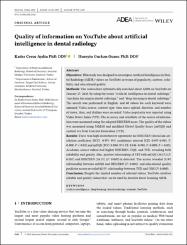| dc.contributor.author | Cesur Aydın, Kader | |
| dc.contributor.author | Güneç, Hüseyin Gürkan | |
| dc.date.accessioned | 2020-11-16T07:19:21Z | |
| dc.date.available | 2020-11-16T07:19:21Z | |
| dc.date.issued | 2020 | en_US |
| dc.identifier.citation | Cesur Aydın, K. ve Güneç, H. G. (2020). Quality of information on YouTube about artificial intelligence in dental radiology. Journal of Dental Education, 84(10), 1166-1172. https://dx.doi.org/10.1002/jdd.12362 | en_US |
| dc.identifier.issn | 0022-0337 | |
| dc.identifier.issn | 1930-7837 | |
| dc.identifier.uri | https://dx.doi.org/10.1002/jdd.12362 | |
| dc.identifier.uri | https://hdl.handle.net/20.500.12511/6032 | |
| dc.description.abstract | Objectives This study was designed to investigate Artificial Intelligence in Dental Radiology (AIDR) videos on YouTube in terms of popularity, content, reliability, and educational quality. Methods Two researchers systematically searched about AIDR on YouTube on January 27, 2020, by using the terms "artificial intelligence in dental radiology," "machine learning in dental radiology," and "deep learning in dental radiology." The search was performed in English, and 60 videos for each keyword were assessed. Video source, content type, time since upload, duration, and number of views, likes, and dislikes were recorded. Video popularity was reported using Video Power Index (VPI). The accuracy and reliability of the source of information were measured using the adapted DISCERN score. The quality of the videos was measured using JAMAS and modified Global Quality Score (mGQS) and content via Total Concent Evaluation (TCE). Results There was high interobserver agreement for DISCERN (intraclass correlation coefficient [ICC]: 0.975; 95% confidence interval [CI]: 0.957-0.985; P: 0.000;P < 0.05) and mGQS (ICC: 0.904; 95% CI: 0.841-0.943; P: 0.000;P < 0.05). Academic source videos had higher DISCERN, GQS, and TCE, revealing both reliability and quality. Also, positive relationship of VPI with mGQS (30.1%) (P: 0.035) and DISCERN (38.1%) (P: 0.007) is detected. The scores revealed 51.9% relationship between mGQS and DISCERN (P: 0.001); and educational quality predictor scores revealed 62.5% relationship between TCE and GQS (P: 0.000). Conclusion Despite the limited number of relevant videos, YouTube involves reliable and quality videos that can be used by dentists about learning AIDR. | en_US |
| dc.language.iso | eng | en_US |
| dc.publisher | Wiley | en_US |
| dc.rights | info:eu-repo/semantics/openAccess | en_US |
| dc.subject | Artificial Intelligence | en_US |
| dc.subject | Deep Learning | en_US |
| dc.subject | Dental Radiology | en_US |
| dc.subject | Internet | en_US |
| dc.subject | Youtube | en_US |
| dc.title | Quality of information on YouTube about artificial intelligence in dental radiology | en_US |
| dc.type | article | en_US |
| dc.relation.ispartof | Journal of Dental Education | en_US |
| dc.department | İstanbul Medipol Üniversitesi, Diş Hekimliği Fakültesi, Ağız, Diş ve Çene Radyolojisi Ana Bilim Dalı | en_US |
| dc.authorid | 0000-0002-6429-4197 | en_US |
| dc.identifier.volume | 84 | en_US |
| dc.identifier.issue | 10 | en_US |
| dc.identifier.startpage | 1166 | en_US |
| dc.identifier.endpage | 1172 | en_US |
| dc.relation.publicationcategory | Makale - Uluslararası Hakemli Dergi - Kurum Öğretim Elemanı | en_US |
| dc.identifier.doi | 10.1002/jdd.12362 | en_US |
| dc.identifier.wosquality | Q3 | en_US |
| dc.identifier.scopusquality | Q2 | en_US |


















